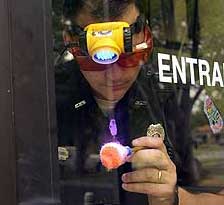An innovative tool developed by a researcher at the Savannah River National Laboratory (SRNL) to give law enforcement personnel a method for on-the-scene fingerprint detection and analysis has been issued a patent by the US Patent and Trademark Office.
The BritePrint device, invented by SRNL’s Eliel Villa-Aleman is a small, lightweight, battery-powered, high-intensity light source that saves investigators valuable time in the investigation process.
The typical method for detecting fingerprints is a slow, cumbersome operation, in which personnel hold a heavy light source – sometimes for hours at a time – while using tape to lift prints, then send the tape back to a laboratory for analysis.

The lightweight BritePrint device would typically be worn on a headset for hands-free operation. Its light emitting diodes (LEDs) produce light that causes areas brushed with dye to be visibly fluorescent.
Wearing light-filtering goggles makes markings in these areas easily detectable by the human eye, allowing an analyst to quickly proceed with on-site identification and analysis of prints. It can also be used with a video camera for recording critical crime scene evidence.
Sequiam Corporation of




Project to investigate hybrid approach to titanium manufacturing
What is this a hybrid of? Superplastic forming tends to be performed slowly as otherwise the behaviour is the hot creep that typifies hot...